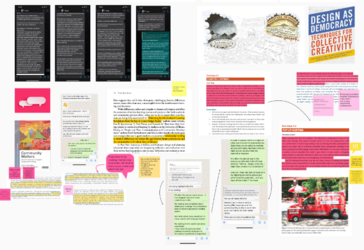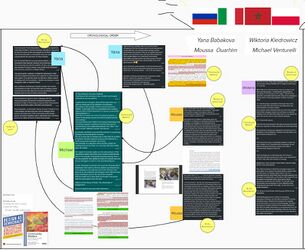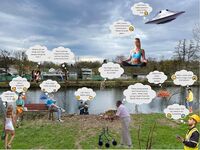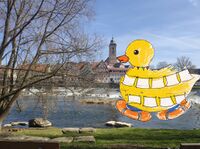LED2LEAP 2021 - Nürtingen Team 6: Difference between revisions
| (52 intermediate revisions by 4 users not shown) | |||
| Line 36: | Line 36: | ||
= Location and Scope = | = Location and Scope = | ||
{{#display_map: 48.61815529211482,9.30905071582917 | {{#display_map: 48.61815529211482,9.30905071582917 | ||
| Line 107: | Line 107: | ||
"Ecological democracy is almost like wedding apparel,” Something old, Something new, Something recurring, Something true.” | "Ecological democracy is almost like wedding apparel,” Something old, Something new, Something recurring, Something true.” | ||
== References == | == References == | ||
| Line 191: | Line 184: | ||
<gallery caption=" " widths="200px" heights="150px" perrow="5"> | <gallery caption=" " widths="200px" heights="150px" perrow="5"> | ||
File: | File:LED_(11).jpg|''Play zone 1'' | ||
File: | File:LED_(12).jpg|''Play zone 2'' | ||
</gallery> | </gallery> | ||
| Line 200: | Line 192: | ||
<gallery caption=" " widths="200px" heights="150px" perrow="5"> | <gallery caption=" " widths="200px" heights="150px" perrow="5"> | ||
File: | File:LED_Phase_D_-_Play_Zone_(2).jpg|''Collect Ideas'' | ||
File: | File:LED Phase D - Play Zone (3).jpg|''Sketch of ideas 01'' | ||
File: | File:LED_Phase_D_-_Play_Zone_(4).jpg|''Sketch of ideas 02'' | ||
File:LED Phase D - Play Zone (5).jpg|''Sketch of ideas 03'' | |||
File:LED Phase D - Play Zone (6).jpg|''Result of Questions'' | |||
</gallery> | </gallery> | ||
== The Plan Behind Your Prototyping Action == | == The Plan Behind Your Prototyping Action == | ||
Our main vision of the Turquoise Belt is to provide safe access to nature and water for all being and future generations. | |||
We imagined the Giant Duck in Nürtingen as a project made of ideas that travel. The more it reaches the community, the more it gets the potential to become in motion. This is why. Make him float on rivers and streams. The feathers of the duck are composed of the draws and the vision of local people. It has the impact to touch the imagination of the society. With the message and draw from kids on the duck, we wanted to expose the voice of the future generation to preserve water and nature. | |||
Also, we believe that this community experience of building a giant duck is a good way to improve communication with the locals. At the end of the drawing session, it was planned to have discussions with local citizens related to their local environment and get valuable information to improve our design. | |||
<gallery caption=" " widths="200px" heights="150px" perrow="5"> | <gallery caption=" " widths="200px" heights="150px" perrow="5"> | ||
File: | File:LED_(16).jpg|''Visulization of idea(floating duck)'' | ||
File: | File:LED_Phase_D_-_Play_Zone_(10).jpg|''Ideas for Floating duck'' | ||
</gallery> | </gallery> | ||
== The Realization of Your Prototyping Action == | == The Realization of Your Prototyping Action == | ||
Due to Covid, for this time, we conducted the prototype online. | |||
== Reflect on Your Prototyping Action == | == Reflect on Your Prototyping Action == | ||
This online session was an opportunity to reach people from different locations and it has helped us to think ‘’outside of the box’’. It has the potential to reach many people at the same time. Online tools have allowed us to perform group drawing sessions on the same canvas and it has certainly brought life to pictures we took of local environments. | |||
The online prototype session was a challenge in terms of time management. Extra time could have been allowed for the drawing phases and comments on each one view of the landscape. | |||
Testing the idea online has also given us the idea that the giant duck could be a virtual duck that people are looking at from their phones around the city (like the concept of Pokemon Go). | |||
= Phase E: Collaborative Evaluation and Future Agendas = | = Phase E: Collaborative Evaluation and Future Agendas = | ||
== Collaborative Evaluation and Landscape Democracy Reflection == | == Collaborative Evaluation and Landscape Democracy Reflection == | ||
*insert text here | *insert text here | ||
== The Actors in your Collaborative Evaluation == | == The Actors in your Collaborative Evaluation == | ||
* | *During the process, we had a really good conversation with people and were surprised about their so active participation and they had so many ideas.For example, we had a discussion with fishermen about the local fishing club and fishing place, fishing requirements. | ||
*Two old ladies shared with us some photos and ideas about having more places for kids along the river and having more beer gardens. | |||
*Two students shared with us interesting ideas about having a dancing place in the center. | |||
*Young lady from the Neckarhausen would like to have a community center in her neighborhood and local place for grill and Fire places. | |||
<gallery caption=" " widths="200px" heights="150px" perrow="5"> | <gallery caption=" " widths="200px" heights="150px" perrow="5"> | ||
File: | File:Slide17.JPG|''Actors'' | ||
File: | File:Slide18.JPG|''Actors'' | ||
</gallery> | </gallery> | ||
| Line 257: | Line 241: | ||
*insert text here | *insert text here | ||
== Reflection on the Living Lab Process == | |||
*On 27 of June we had a chance to organize Living Lab Even for Prototyping Activity. With help of Amelie and Ellen, we found this place in the center of Nürtingen. It is located on Aleenstrasse along the river Neckar, And it’s closed for cars during the weekend and surrounded by cafes and restaurants. So people were relaxed and had plenty of time to participate in our Prototype activities and have time for conversation with us. | |||
*We prepared some tables and chairs that people could sit and learn more about us and our project. We prepared some big maps, one is the big map of the city Nurtingen to ask people about places that they like and they don’t like We also presented our Turqious Belt project with easy legends and symbols also a map of the river Neckar to ask people about accessibility to the river in different places. We also had some printed pictures from the site which people also could use for reactions and for drawings. we prepared colourful markers and stickers that people could use during the process. | |||
*During the discussion with local people, we realize that we could find so many good solutions for the future of this city and also we could share our knowledge with each other – some ideas were found during this good conversation. | |||
So finally we got this result, a collection of stickers drawings and of course memories. | |||
<gallery caption=" " widths="200px" heights="150px" perrow="5"> | <gallery caption=" " widths="200px" heights="150px" perrow="5"> | ||
File: | File:Slide13.JPG|''Location of Living Lab'' | ||
File: | File:Slide14.JPG|''Preparation of Living Lab'' | ||
File: | File:Slide15.JPG|''Living Lab Inputs'' | ||
File:Slide16.JPG|''Living Lab Participation'' | |||
File:Slide19.JPG|''Turquoise Belt map'' | |||
</gallery> | </gallery> | ||
== Your Living Lab Code of Conduct == | == Your Living Lab Code of Conduct == | ||
*insert text here | *insert text here | ||
== Process Reflection == | == Process Reflection == | ||
*insert text here | *insert text here | ||
Latest revision as of 22:11, 16 July 2021
>>>back to working groups overview
For help with editing this Wiki page use this link.
For assignments and key readings use this link.
| Area | Neckarhausen | |
| Place | Nürtingen | |
| Country | Germany | |
| Topics | Accessibility to the river Neckar | |
| Author(s) | Gabriel, Yana, Digjam, Titiksha, Manasviben | |

| ||
Landscape Democracy Rationale
- The location of Neckarhausen in close proximity to the main road (Neckarstraße) in the south, is the primary landscape challenge for this village. This area is separated from the river by the noisy road, which not only makes it impossible to access the river but also is the main reason for air pollutions.
- Local people prefer to stay at home or to relax in the gardens, but only a part of houses has territory for gardens or orchards. The historical center is the only public place for citizens of all ages, especially young people who like skating and cycling on the streets. The riverbank has a lot of potentials to be a new space for communication between groups of people in Neckarhausen.
Location and Scope
Phase A: Mapping Your Community
Welcome to Your Community and Their Landscape
- Neckarhausen is a small German village located in the Neckar River Valley and is a part of Nürtingen city. The earliest record of the local community date of 1284 and the current population of the city is 3,934 inhabitants. The city has been developed around a church and a town hall. The urban space is surrounded by the river, mountain, orchards, intensive agriculture, and some forest area.
- At the earliest, Neckarhausen has benefited from the exploitation of local resources and the use of the Neckar river as a transportation channel for logs has been a major transformation for the local communities along the river.
- Nowadays, Orchards and Agriculture are also part of the village cultural heritage and offer good potential for tourism to visit the community. However, fisheries and wood exploitation are no longer a way to meet society's needs.
- It is important to mention that the Baden-Wurttemberg province offers a highly favorable environment for business and the proximity of Stuttgart offers Neckarhausen people multiple opportunities in industries and services. The Covid may have also an impact on the local economy and work from home might become more common.
Groups of Actors and Stakeholders in Your Community
- The community of this small village is composed of teenagers, children, young families, workers, single, elders, and farmers. Also, some local businesses and government institutions can be found in the territory of Neckarhausen. The local authority is led by member of the municipality council of Nürtingen city. Other non-obvious actors such as fishermen and animals can be mentioned in the list of stakeholders.
- The lack of accessibility to the river and natural areas is a challenge in this area. People do not have a lot of great quality urban spaces for gatherings and meetings near. Teenagers and children play and ride skateboards on the streets, older people use religious places such as churches to meet each other. In addition, young families also need a place for different types of activities and for socializing, not only territories of schools and kindergartens. Citizens of Neckarhausen like to be outside, doing gardening activities and go for a walk, enjoy nature and views. However, the main road, design just by the river creates a division between settlement and the river. Historically, the village has been founded on the proximity of the water and this important connection to the community seems to vanish. Fortunately, by crossing on of the city bridge to =the other shore, there's a lot of open space available to people.
Relationships Between Your Actors and Groups
The leading authority of the Neckarhausen village is the city of Nürtingen. The decentralization of the power from the community could be a problem in creating unity. In terms of the landscape transformation, the local business, farmers, schools, landowners depend on the municipality, and the group with less power are the teenagers and students. We observed that younger people tend to have less power in terms of space design.
With the 2019-2021 Covid pandemic situation, relationships between actors and groups in Neckarhausen have been greatly influenced by social distancing limits. Isolation could create a certain division and misunderstanding in the community.
People in the Baden-Württemberg area tend to enjoy outdoor activities and nature. The pandemic has pointed out how much natural space, trees, water, and fresh air are vital to a healthy community.
Although, creating a better environment, in order to promote socialization could be a great opportunity to share ideas and improve the understanding of everyone's needs and ambitions.
Summary of Your Learnings from the Transnational Discussion Panel
- Participation in discussions with students from different Universities and from different countries was so helpful for us for a broader understanding of various analyses and goals as well as communities around the world. We learned a lot from graphical presentations and it can help us to improve our project in the future.
Theory Reflection
- During the reading of literature from “key reading” we have found many interesting statements which inspired us and helped us to feel how important landscape democracy in theory and practice.
- Uwe Schneidewind, Mandy Singer-Brodowski, Karoline Augenstein and Franziska Stelzer (2016) Pledge for a Transformative Science
"Transformative science, which is defined as a specific type of science that does not only observe and describe societal transformation processes but rather initiates and catalyzes them. Transformative science aims to improve our understanding of transformation processes and to simultaneously increase societal capacity to reflect on them."
"The relationship between scientists and society has to be redefined where they take real-world problems as the starting point for research, where research questions are framed together with societal stakeholders, and where different types of disciplinary and non-academic knowledge need to be integrated."
- Shelley Egoz, Karsten Jørgensen and Deni Ruggeri (2018) Defining Landscape Democracy
"Landscape, in its wider conceptual sense, is the life support system for human and ecological communities. Physical, mental, emotional, economic, social and cultural wellbeing depends in large part on inclusive planning and management of the landscape."
"Its mission is: To lead, host and provide a conceptual framework in order to motivate high-quality research discourses and practices associated with democracy, rights and public engagement in landscape functions, patterns, and change."
- Randolph T. Hester (2006) Design for Ecological Democracy
"This book is about building ecological democracy through design. Places that attract an informed and active citizenry, that are resilient ecologically, and that enhance our lives through their livability are the foundation for an ecological democracy that is essential to our nations long term health and to lives that are more than most of us presently live."
"Ecological democracy is almost like wedding apparel,” Something old, Something new, Something recurring, Something true.”
References
- Pledge for a Transformative Science, Uwe Schneidewind, Mandy Singer-Brodowski, Karoline Augenstein and Franziska Stelzer (2016)
- Defining Landscape Democracy, Shelley Egoz, Karsten Jørgensen and Deni Ruggeri (2018)
- Design for Ecological Democracy, Randolph T. Hester (2006)
Phase B: Democratic Landscape Analysis and Assessment
Gabriel-Hugues André Ouellet and Chloé Camérola Correspondence
- ''insert text here''
Titiksha Rohit and Lara Ćuk Correspondence
Manasviben satani,Michalina Jasinsk and Tímea Žolobaničová
Yana Babakova, Wiktoria Kiedrowicz, Michael Venturelli and Moussa Ouarhim Correspondence
Phase C: Collaborative Visioning and Goal Setting
The Scene in Your Story of Visioning
- Neckarhausen people have the chance of living near the water. However, since the construction of the main road near the river, the community has lost important access to the river. Also, animals are struggling to reach the forest because of the danger of the roads.
- The village of almost 4000 residents is part of the Stuttgart region and due to the rapid economic growth, industrialization of agriculture has also created a major loss to the biodiversity of the region.
- It’s time for the citizen of the village and the wildlife of the region to reclaim their right to access water and healthy nature.
The Actors in Your Story of Visioning
- In the Neckarhausen identify different actors group. For example farmers, sportsperson, International students, Business people, kids, younger people, Elder, couples, Fisherman, Architect and many others.
- There are some helpful organization like local government of Nürtingen , University of Landscape Architecture , Environmental conservation agency , social group , local Industries who helps to reach towards goal.
The Story of Visioning
Reflect on Your Story of Visioning
Formulating goals with multiple actors could be a challenge. At the base, we need to be sure that everybody gets soaked as much as possible about the context of the desired intervention area. It will provide essential knowledge of the strength and weaknesses of an area and will help to make more strategic decisions when will come the time to choose between the most relevant goals.
The first contact with the actors is also very important, as we should always aim to improve the communication within the community. A good understanding of each other will generate unity within the community and offer the chance to share more easily the vision we want everybody to participate in.
A vision at the beginning could be blurry and it’s the role of the leader to make it clearer. He could be an expert or people within the community and his role is to take the complex situation and make it simpler so that everybody can understand and join in the common vision.
Phase D: Collaborative Design, Transformation and Planning
Your Prototyping Action
- insert text here
The Evolution of Your Prototyping Action
- insert text here
The Plan Behind Your Prototyping Action
Our main vision of the Turquoise Belt is to provide safe access to nature and water for all being and future generations. We imagined the Giant Duck in Nürtingen as a project made of ideas that travel. The more it reaches the community, the more it gets the potential to become in motion. This is why. Make him float on rivers and streams. The feathers of the duck are composed of the draws and the vision of local people. It has the impact to touch the imagination of the society. With the message and draw from kids on the duck, we wanted to expose the voice of the future generation to preserve water and nature.
Also, we believe that this community experience of building a giant duck is a good way to improve communication with the locals. At the end of the drawing session, it was planned to have discussions with local citizens related to their local environment and get valuable information to improve our design.
The Realization of Your Prototyping Action
Due to Covid, for this time, we conducted the prototype online.
Reflect on Your Prototyping Action
This online session was an opportunity to reach people from different locations and it has helped us to think ‘’outside of the box’’. It has the potential to reach many people at the same time. Online tools have allowed us to perform group drawing sessions on the same canvas and it has certainly brought life to pictures we took of local environments.
The online prototype session was a challenge in terms of time management. Extra time could have been allowed for the drawing phases and comments on each one view of the landscape.
Testing the idea online has also given us the idea that the giant duck could be a virtual duck that people are looking at from their phones around the city (like the concept of Pokemon Go).
Phase E: Collaborative Evaluation and Future Agendas
Collaborative Evaluation and Landscape Democracy Reflection
- insert text here
The Actors in your Collaborative Evaluation
- During the process, we had a really good conversation with people and were surprised about their so active participation and they had so many ideas.For example, we had a discussion with fishermen about the local fishing club and fishing place, fishing requirements.
- Two old ladies shared with us some photos and ideas about having more places for kids along the river and having more beer gardens.
- Two students shared with us interesting ideas about having a dancing place in the center.
- Young lady from the Neckarhausen would like to have a community center in her neighborhood and local place for grill and Fire places.
Reflection on the Online Seminar
- insert text here
Reflection on the Living Lab Process
- On 27 of June we had a chance to organize Living Lab Even for Prototyping Activity. With help of Amelie and Ellen, we found this place in the center of Nürtingen. It is located on Aleenstrasse along the river Neckar, And it’s closed for cars during the weekend and surrounded by cafes and restaurants. So people were relaxed and had plenty of time to participate in our Prototype activities and have time for conversation with us.
- We prepared some tables and chairs that people could sit and learn more about us and our project. We prepared some big maps, one is the big map of the city Nurtingen to ask people about places that they like and they don’t like We also presented our Turqious Belt project with easy legends and symbols also a map of the river Neckar to ask people about accessibility to the river in different places. We also had some printed pictures from the site which people also could use for reactions and for drawings. we prepared colourful markers and stickers that people could use during the process.
- During the discussion with local people, we realize that we could find so many good solutions for the future of this city and also we could share our knowledge with each other – some ideas were found during this good conversation.
So finally we got this result, a collection of stickers drawings and of course memories.
Your Living Lab Code of Conduct
- insert text here
Process Reflection
- insert text here






































